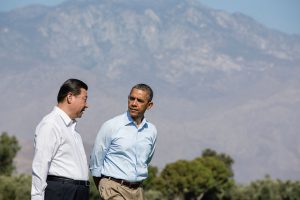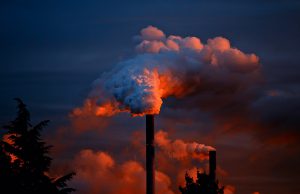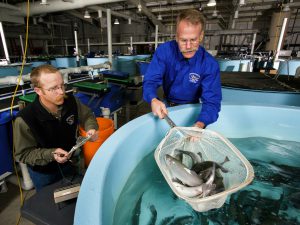China is the largest contributor to America’s trade deficit by some margin, with official US statistics showing that in 2016 the deficit with China represented US$347 billion – almost half of the national total. Since taking power President Donald Trump has adopted a new approach to trade with China.
After meeting with Xi Jinping at Mar-a-Lago in April a “100 Day Plan” of trade talks commenced between the two nation’s leaders. From the US side, these were aimed at reducing the trade deficit, pushing China to relax rules on financing and investment, and to drop the ban on US beef imports. A new trade deal between the two nations was agreed.
The US negotiators may go even further, pushing China to agree to import more US soya, corn, pork and chicken. On April 20 Trump announced an investigation into the national security implications of steel imports, which some manufacturers claimed was aimed at restricting the import of steel products from China.
But what environmental impacts will the new trade terms have if implemented?
Greener imports
Currently, China imports US$15 billion of agricultural products every year from the US, including soya, corn and meat. Increasing imports from the US would relieve pressure on China’s own environment. In particular, there would be large reductions in the pollution of surface water.
Farming is a major contributor to pollution in China. According to figures in the 2014 Report on the State of China’s Environment, livestock and poultry farming released 104.9 million tonnes of Chemical Oxygen Demand (COD), the amount of pollution that cannot be oxidized biologically in surface water), and 580,000 tonnes of ammonia in 2014. This represents 95% and 77% of the agricultural sector total for that year; and 46% and 25% of the overall national total.
China’s farming sector has become the biggest contributor to water pollution, outstripping industrial and household sources. According to research carried out by the WWF in partnership with Beijing Normal University and Qingdao University of Science and Technology, China’s meat sector emits 0.12-0.36 tonnes of COD for every 10,000 yuan of output. That means that importing US$1 billion of meat from the US could reduce COD emissions in China by 82,800 tonnes to 248,400 tonnes, or expressed another way, 0.8-2.37% of total COD emissions from the meat sector.
Last year China’s total importation of agriculture products are about US$50 billion. If US imports to China rise 20% in the medium to long term to the value of US$10 billion, then reductions will increase tenfold. This would be of huge benefit to China’s water environment. It would also help China improve its economic structure, eliminating polluting and resource intensive industries and making full use of China’s comparative advantages.
China: Fewer exports means less pollution
The US has long restricted imports of steel from China. For several years the US has implemented anti-dumping and anti-subsidy measures, resulting in sharp drops in imports of Chinese steel. Between January and November 2016 the US imported just over one million tonnes of steel from China, less than half of that in the same period in 2015.
In February 2017 the US raised its anti-dumping tax on Chinese steel from 63.8% to 76.6%. The Trump administration later announced a wide-ranging investigation into whether or not those imports represent a threat to national security. This may lead to additional taxes on Chinese steel, thereby reducing imports further.
The steel sector, particularly in the Beijing-Tianjin-Hebei region, has a huge impact on air pollution. For every 10,000 yuan (US$1,450) of steel output, China’s most advanced steel mills use almost one tonne of coal equivalent (TCE) of energy and emit three tonnes of carbon dioxide (CO2) and other harmful pollutants, including three kilogrammes of sulfur dioxide (SO2) and 1.4 kilogrammes of nitrogen oxides (NOx).
If steel exports to the US fell in the short term by US$10 billion, and assuming that the same amount was not produced in the home market, China would use 6.74 million TCE less. This represents 10.7% of planned reductions in coal consumption for the Beijing-Tianjin-Hebei region for 2012-2017.
Emissions of CO2 would fall by 20.85 million tonnes, SO2 by 21,000 tonnes and NOx by 9,800 tonnes – again, roughly 10% of planned reductions for the Beijing-Tianjin-Hebei region for 2012-2017. This would mean great improvements for China’s air quality in the region. It would also help China achieve its targets for reducing steel capacity and upgrading the sector.
Overall, increased imports for meat from the US and decreased exports of steel to the US could easily be beneficial for the environment in China.
US: Taking back the jobs, taking back the pollution
If Trump’s policies on trade with China are implemented it might help him bring jobs back to the US. But what would that mean for the environment there? Or for the global environment? Increased meat exports to China would result in more water pollution in the US; fewer steel imports would increase emissions of greenhouse gases and atmospheric pollutants as US production increased.
Fortunately the US has much greater environmental capacity than China and a tougher regulatory regime so the manufacture of these products in the US would have a smaller environmental impact than in China. So for the global environment the trade realignment would likely shift pollution from China to the US, but reduce it overall.







![The Indus at the site of the proposed Diamer-Basha dam [image by: Water and Power Development Authority, Pakistan]](https://dialogue.earth/content/uploads/2017/05/Indus_Diamer_Basha_Dam_Site_Image_WAPDA-300x169.jpg)